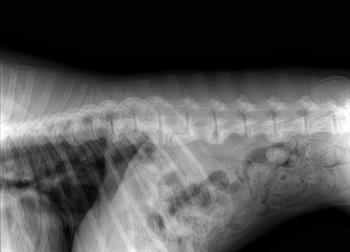Radiograph of a Dog with Spondylosis Deformans

Courtesy of Dr. Dai McWhorter
Spondylosis deformans is a noninflammatory, degenerative condition of the spinal column characterized by the production of bone spurs along the bottom, sides, and upper aspects of the vertebrae. These growths are usually due to aging, injury (repetitive microtrauma to the same joints and bones through repeated exercise or other activities, or major trauma/injury), or a genetic predisposition to bone spurs.
In dogs, spondylosis deformans occurs most often along lower back (lumbar) vertebrae. In cats, it tends to occur more often in the chest (thoracic) vertebrae.
Signs and Symptoms
Most affected animals show no signs, although the pet owner may be able to feel the bone spur. The animal may be stiff in the spine, and have restricted motion. If the bony spurs or bridges fracture, the pet may be painful, be lame, or show other neuromuscular signs associated with damage to the spinal cord or spinal nerves. The signs that will be seen will depend on the location of the deformity in the spine.
Diagnosis
Diagnostic tests may include a physical exam, a biochemical profile, a complete blood count, a urinalysis, an electrolyte panel, and diagnostic imaging (radiographs, computed tomography [CT scan], myelography, or magnetic resonance imaging [MRI]). The radiographs will reveal the bony growths, but CT scans, myelography, and MRI may be necessary if the bone spurs are pushing on the spinal cord or associated nerves.
Treatment
Patients without symptoms don't need any treatment.
If the pet is dealing with only pain and stiffness, conservative treatment (weight reduction, controlled exercise or physiotherapy, and non-steroidal anti-inflammatory drugs) will usually be used.
If a growth is causing more severe pain, or the spur is damaging the nerves or other tissues as shown by your veterinarian's neurological exam, your veterinarian may advise surgery.
Prognosis
If there are no symptoms, owners may never know that their pets have or had the condition. Even if dogs or cats are somewhat limited in flexibility and range of motion, they will live a satisfactory life. Your veterinarian will discuss the prognosis for your pet based on diagnostic testing and/or the response to treatment.